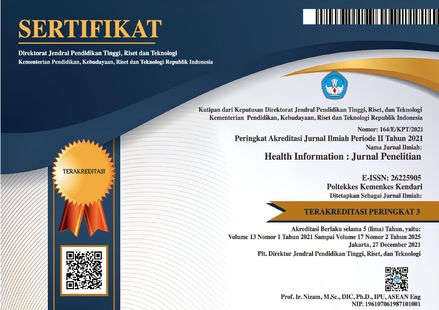Detection of Uterine Contractions in Mothers in the First Stage of Active Phase Using Instruments Uterine Electromyograpy
DOI:
https://doi.org/10.36990/hijp.v16i2.1494Keywords:
Uterine Contractions, Uterine Electromyography, Labor, First Stage Active PhaseAbstract
The maternal mortality rate is still quite high in 2022, which is 3,572 people, efforts are still needed so that the target of Indonesia's golden age of 2030 can be achieved. Prevention of complications during labor will reduce maternal morbidity and mortality. One of the important components that must be monitored in labor is uterine contractions to identify complications in the labor process. Dystocia in labor can also be caused by abnormal contractions, the impact of this on the mother is intrapartum infection, uterine rupture, fistula formation, pelvic floor muscle injury. While in the fetus it has the potential to cause caput succedaneum and fetal head molasses and can even result in skull fractures if labor management is not carried out properly. Detection of uterine contractions with uterine electromyography using surface electrodes is considered an innovation in monitoring his that is considered effective and efficient, accurate and without risk. This article review aims to analyze the use of uterine contraction detection tools in mothers in labor using uterine electromyography. The article review method is a systematic review of the PICO question formulation by searching for article titles in online databases (ProQuest, Sage Journal, Science Direct, Scopus and googlescholar). The reviewed articles have met the inclusion criteria. The results obtained in general can be concluded that uterine contractions in women in labor can be detected using uterine electromyography based on the measurement of uterine muscle electricity during contractions which can be further developed to produce an accurate and easy-to-use uterine contraction examination tool.
References
Alberola-Rubio, J., Prats-Boluda, G., Ye-Lin, Y., Valero, J., Perales, A., & Garcia-Casado, J. (2013). Comparison of non-invasive electrohysterographic recording techniques for monitoring uterine dynamics. Medical Engineering and Physics, 35(12), 1736–1743. https://doi.org/10.1016/j.medengphy.2013.07.008
Amartha, T. A. S. (2018). Uterine Electrical Activity During First Stage of Labor. Journal of Medical Science And clinical Research, 6(1). https://doi.org/10.18535/jmscr/v6i1.61
Arrabal, P. P. dan N. D. A. (1996). is manual palpation of uterine contractions accurate? Am J Obstet Gynecol, 9–217.
Elyasari, E., Feryani, F., Aisa, S., & Arsulfa, A. (2022). Pendampingan Persalinan oleh Suami Berpengaruh terhadap Lama Persalinan Kala 1: Penelitian Kuasi Eksperiman. Health Information?: Jurnal Penelitian, 14(2). https://doi.org/10.36990/hijp.v14i2.763
Garfield, R. E., Maner, W. L., MacKay, L. B., Schlembach, D., & Saade, G. R. (2005). Comparing uterine electromyography activity of antepartum patients versus term labor patients. American Journal of Obstetrics and Gynecology, 193(1), 23–29. https://doi.org/10.1016/j.ajog.2005.01.050
Hassan, Mahmoud, Terrien, Jeremy, Alexandersson, Asgeir, Marque, Catherine, Karlsson, & Brynjar. (2010). Nonlinearity of EHG Signals Used to Distinguish Active Labor from Normal Pregnancy Contractions.
Hutten, G. J., van Thuijl, H. F., van Bellegem, A. C. M., van Eykern, L. A., & van Aalderen, W. M. C. (2010). A literature review of the methodology of EMG recordings of the diaphragm. Dalam Journal of Electromyography and Kinesiology (Vol. 20, Nomor 2, hlm. 185–190). https://doi.org/10.1016/j.jelekin.2009.02.008
Ibrahim, N., & Surya Indah Nurdin, S. (t.t.). Pengaruh Anemia Terhadap Inersia Uteri Di Rumah Sakit Umum Daerah Prof. Dr. H. Aloei Saboe Kota Gorontalo.
Pajntar, M., Ïek, L., Rudel, D., & Verdenik, I. (t.t.). Contribution of cervical smooth muscle activity to the duration of latent and active phases of labour. www.bjog-elsevier.com
Profil Kesehatan Indonesia 2022. (T.T.).
Rahayu, R. M., & Rahmadyanti, R. (2023). Perbandingan Pemberian Tehnik Rebozo dan Pijat Oksitosin terhadap Lama Persalinan di Puskesmas Sukatani Kabupaten Bekasi Jawa Barat. . Health Information?: Jurnal Penelitian,.
Rhomadona, S. W., Widyawati, M. N., & Suryono, S. (2019). Monitoring of Uterus Electrical Activities using Electromyography in Stage i Induction Labor. Journal of Physics: Conference Series, 1179(1). https://doi.org/10.1088/1742-6596/1179/1/012133
Saifudin A. B. (2009). Ilmu Kebidanan Sarwono Prawiroharjo. PT. Bina Pustaka Sarwono Prawiriharjo.
Vasak, B., Graatsma, E. M., Hekman-Drost, E., Eijkemans, M. J., Schagen Van Leeuwen, J. H., Visser, G. H., & Jacod, B. C. (2013). Uterine electromyography for identification of first-stage labor arrest in term nulliparous women with spontaneous onset of labor. American Journal of Obstetrics and Gynecology, 209(3), 232.e1-232.e8. https://doi.org/10.1016/j.ajog.2013.05.056
Verdenik, I., Pajntar, M., & Leskos Ïek, B. (t.t.). Uterine electrical activity as predictor of preterm birth in women with preterm contractions.
Downloads
Published
How to Cite
Issue
Section
Citation Check
License
Copyright (c) 2024 Pratiwi Pratiwi, Melyana Nurul Widyawati, Kurnianingsih (Author)

This work is licensed under a Creative Commons Attribution-ShareAlike 4.0 International License.
Authors retain copyright and grant the journal right of first publication with the work simultaneously licensed under a Creative Commons Attribution-ShareAlike 4.0 International License that allows others to share the work with an acknowledgment of the works authorship and initial publication in this journal and able to enter into separate, additional contractual arrangements for the non-exclusive distribution of the journals published version of the work (e.g., post it to an institutional repository or publish it in a book).
















